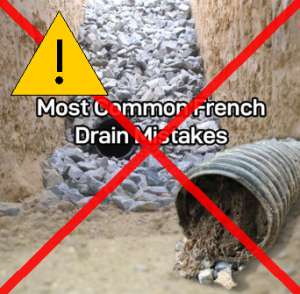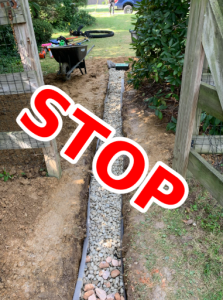French Drain Miami

Thinking about a French drain in Miami? Read this first. Coastal neighborhoods, king tides, backwater from Biscayne Bay/canals, and a seasonally high water table mean a basic “trench + pipe” often doesn’t work here. We’re called in month after month after a homeowner spent $4,000–$5,000 on a quick install that failed. That money is gone—and we still have to design and build the correct fix.
Start with the statewide overview: French Drain (Florida) Hub
Why Miami Is Hard on French Drains
- Backwater & tides: When tides or canal stages rise, the outlet elevation can be higher than your yard line. The available head goes to zero or negative—your French drain stalls or backs up.
- Seasonal water table: Groundwater sits high and pushes higher during rainy season and king tides. A shallow trench often sits in groundwater and stops intercepting.
- Flat grades: Without a 1–2% slope to a legal outlet, a trench becomes a storage tube—not a drain.
- Storm bursts: Summer cells routinely deliver 2–3 in/hr. One downspout from a typical roof can saturate a 4″ line before yard inlets add a drop.
- Salt & corrosion: Coastal air accelerates metal component wear (fasteners, flimsy grates, cheap check valves) if the system isn’t specified correctly.
We’re blunt because we see this weekly: low-bid landscapers/handymen ignore hydraulics, combine roof and yard lines, bury perforated pipe below the seasonal water table, and “outlet” to places that drown on high tide. The result is a pretty trench that doesn’t move water.
Related resources: Drainage Problems • Structural Waterproofing • Efflorescence & Slab Moisture • Forensic Structural Inspection
Miami Drainage—By the Numbers

Most Common Miami Mistakes (What We Fix)
- Combining downspouts with yard inlets upstream: Roof lines are under head (high inflow). They overpower yard grates, so the “French drain” never gets a chance.
- No positive outfall: The curb/canal is above your pipe during high tide. Without check valves (tide/backwater) and/or a sump + pump, the system stalls or backflows.
- Below water table: Trench elevation sits in seasonal groundwater; interception stops when you need it most.
- Wrong (or no) fabric: Landscape cloth or no wrap = fines migration, clogged voids, dead system. Use the correct non-woven and lap joints ≥ 1 ft (see FDOT).
- Illegal discharge: Outlets to the street, alley, neighbor’s yard, or seawall weep holes can violate code/HOA rules and still fail at high tide.
Our Engineer-Designed Approach (Miami)

- Diagnostics & elevations: Laser levels confirm fall; we check the outfall invert vs. local tide stages (king tides, canal stages) and identify seasonal high water table.
- Hydraulic sizing: We calculate roof/yard inflows using NOAA Atlas 14 PFDS and select pipe sizes based on actual gpm and slopes.
- Flow separation: Roof conveyance on its own solid line. Yard inlets/French drains on a separate trunk; tees only downstream with backwater control.
- Right system for the site:
- If gravity works at all stages: Properly sloped perforated line, #57 stone, non-woven wrap, cleanouts, and a legal, protected outfall (check valve/flap gate).
- If gravity fails at tide: Sump basin + pump (head/curve matched), check valve, power, and piping to an approved discharge.
- Structural protections: Where groundwater drives slab/wall moisture, we add membranes & vapor control to stop efflorescence and mold from returning.
About the Engineer
Jeff Earl — Structural/Forensic & Water-Hydraulics Engineer
20+ years in structural evaluation and forensic engineering. Jeff also works as a
water hydraulics engineer—meaning he calculates, not guesses, how water moves through Miami soils, tides, and drains.
For footer drains he follows I-Code principles (drain at/just below top of footing on ≥2″ washed stone, covered by ≥6″ stone, wrapped in a non-woven geotextile, discharged to an approved outlet).
Hydraulically, a 4″ corrugated at 0.5–1.0% slope moves about ~36–51 gpm; a 4″ smooth SDR-35 at the same slopes moves ~71–101 gpm.
A modest 2,500 ft² roof at 2.5 in/hr already produces ~64.9 gpm—enough to overwhelm a shared 4″ “French drain” before yard inlets add flow. That’s why Jeff separates roof conveyance from groundwater relief, designs for positive slope, protects outfalls from tide backwater, or specifies a sump + pump where gravity won’t work.
Neighborhoods We Serve
Miami Beach • Key Biscayne • Coconut Grove • Coral Gables • Brickell • Edgewater • Midtown • Little Havana • Shenandoah • The Roads • South Miami • Pinecrest • Palmetto Bay • Kendall • Aventura • Sunny Isles • Miami Shores • North Miami • Doral • Homestead and more across Miami-Dade.
French Drain Miami — FAQs
Will high tide make my French drain back up?
It can. If the outfall invert is below tide stage, available head drops to zero or negative. Use backwater valves/flap gates and, when needed, a sump + pump to maintain discharge during king tides.
Can I send water to the canal or street?
Only where approved. The Florida Plumbing Code requires stormwater to reach an approved place of disposal. We design legal, protected outfalls and secure the approvals that apply.
Should roof downspouts tie into the French drain?
We recommend separate conveyance. One downspout in a 2–3 in/hr burst can saturate a 4″ line. Combine only downstream with adequate pipe size and backwater/check protection.
Engineer-Designed French Drains That Actually Work in Miami
Miami’s drainage challenges — seasonal high water table, king tides, flat grades, and backwater from Biscayne Bay and canals — make most “landscaper installed” French drains fail quickly. A simple trench and perforated pipe often sits underwater during rainy season or tide surge and can’t move water. Many homeowners spend thousands on systems that stall, backflow, or clog within a year because no one verified slopes, outlet elevation, or hydraulic capacity.
At Foundation Waterproofing 101, every drainage plan is designed by Jeff Earl, licensed water hydraulics and forensic engineer. We measure elevations with laser levels, compare your outlet invert to local tide stages, and size piping based on actual roof and yard runoff using NOAA rainfall data. Roof and yard drainage are separated so flows don’t overwhelm small pipes. Outfalls are protected with backwater valves or sump-and-pump systems when gravity alone won’t work.
Materials are specified for Miami’s soil and salt exposure — washed #57 stone, non-woven geotextiles, smooth PVC or SDR-35 pipe for higher flow, and corrosion-resistant valves and grates. Installations are code-compliant, legal, and designed to perform through king tides and storm bursts, not just look good on day one.
If you’ve had standing water, flooding after heavy rain, or a failed French drain, schedule a professional evaluation. Request a drainage assessment or call 813-614-4830. We’ll design a system built for Miami’s unique conditions — one that actually works when you need it most.
